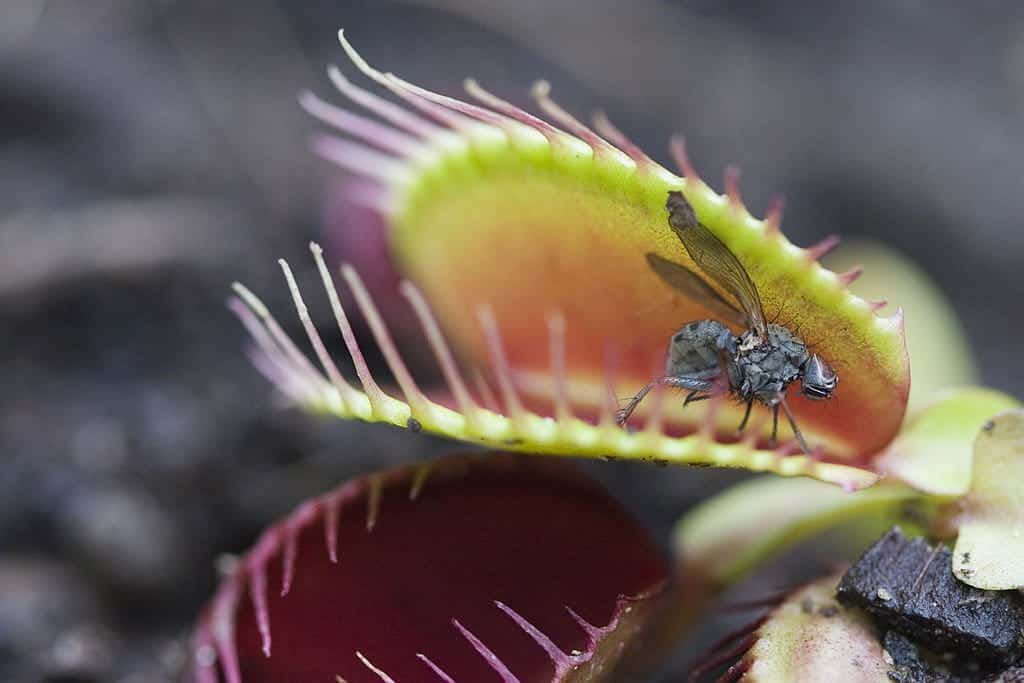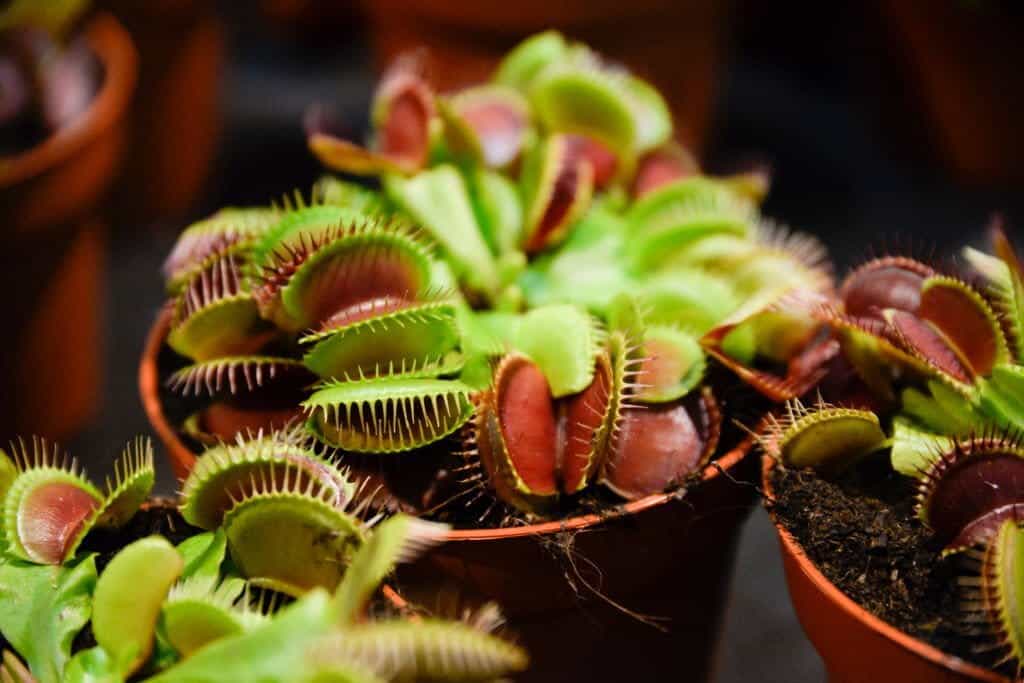Many people ask me, “ Do venus fly traps eat gnats?’’
The Venus flytrap (also called Dionaea muscipula), according to Wikipedia, is a carnivorous plant native to subtropical wetlands in North and South Carolina. It catches its prey – mostly insects and arachnids by using a trapping device made by the terminal region of each of the plant’s leaves, which is triggered by small hairs on the inner surfaces of the leaves.
Venus flytraps eat a variety of insects. Flies, as well as ants, gnats, worms, and spiders, are among the bugs they devour.
At home, Venus Flytraps can help you get rid of gnats and other pesky insects. Many households cultivate Venus Flytraps to lessen the number of insects in their kitchens because of this unique trait.
Is this plant, nevertheless, truly assisting you in making your kitchen airier than you imagined? To find the answer, read all the way to the end.
How does the Venus flytrap digest flies?
It begins by luring its prey with sweet-smelling nectar hidden beneath its steel-trap-shaped leaves.
Unsuspecting animals land on the leaf in quest of a reward, only to be trapped behind the interlocking teeth of the leaf edges by the bristly trigger hairs on the leaf.
On the surface of each leaf, there are three to six trigger hairs. The cells on the outer surface of the leaf expand fast and the trap clamps shut instantly if the same hair is touched twice or two hairs are touched within a 20-second period.
If the trap is stimulated by insect secretions such as uric acid, it will clamp down even harder on the prey and establish an airtight seal.
The digestive glands that border the inside edge of the leaf emit fluids that dissolve the soft parts of the prey, kill germs and fungi and break down the insect with enzymes to obtain the necessary nutrients once the trap shuts.
These nutrients are absorbed by the leaf, and the trap will reopen five to twelve days after capture to release the exoskeleton.
The trap will stop catching prey after three to five meals and will spend another two to three months photosynthesizing before dropping off the plant.
Venus flytraps can eat gnats and can act as a gnat controller in some cases. Other carnivorous plants can be utilized to manage gnats if you have a gnat problem. These are far more effective than Venus flytraps and will assist you in solving your problem.
How to help Venus flytraps grow well
It might be difficult to care for Venus flytraps and keep them alive. To live, Venus flytraps require highly specialized habitat. Please follow the instructions below to ensure that your plant thrives.
Lighting Condition
Venus flytraps need a lot of sunlight, moist soil, and nutrient-free ground to thrive. Venus flytraps flourish in the presence of food (insects or arachnids) and do not require fertilizer. These carnivorous plants are prone to root rot, light deficiency, and pests.
Venus flytraps need at least 12 hours of direct sunshine to thrive. They can, however, have a healthy life if they get enough sunlight. A minimum of 6 hours of indirect sunlight is recommended.
If a plant light is available, Venus flytrap can be grown indoors in windowless homes. High-output fluorescent lights or LED lights can be used.
Water Type
Venus flytraps cannot drink tap or bottled water because it contains too many minerals and nutrients. These plants demand mineral-free, nutrient-free water. You can use any pure water source, including rainwater, distilled water, and reverse osmosis water.
In humid settings, Venus flytraps thrive. The soil in which Venus flytraps grow should be kept moist at all times; it should never be fully dry. Water the soil from the top or from the bottom until it is moist all the way through.
Read more: Top 10 Best Plants For Self Watering Pots
Soil
Use mineral-free, nutrient-free soil. A mixture of moss and a draining agent is a suitable option for carnivorous plant soil. Sphagnum moss or peat moss, as well as silica sand or perlite, can be used as draining agents.
Some other plants
Due to their small size and a limited number of leaves, Venus flytraps are ineffective pest controllers (particularly for fruit flies). Other carnivorous plants, such as Sundews, Pitcher plants, and Butterworts, are better at controlling pests.
Butterworts
Because of the sticky material contained in their leaves, this type of carnivorous plant can easily attract insects.
These carnivorous plants generate sticky leaves with a gleaming luster. The leaves attract insects, and they become stuck as soon as they land on the plant.
They are commonly found in humid mountainous locations such as Central and South America, as well as Mexico.
Butterworts are excellent at catching flying insects, particularly small ones like fruit flies. They have the ability to catch a large number of little insects.
Indoors, butterworts can be grown. They can be cultivated indoors or outdoors, depending on the region, and do not require a temperature change to go dormant.
Sundews
Sundews, also known as Drosera, have tentacles on their leaves that exude sticky chemicals to catch animals.
Sundews come in a variety of shapes and sizes. Before purchasing, I recommend doing some research on the exact variety. Some sundews may be grown indoors, while others need to be exposed to direct sunlight. In addition, each kind of Sundew has varied temperature and dormancy requirements (not all Sundews need dormancy).
Nepenthes Pitcher Plant
Nepenthes feature pitcher-like structures at the end of their leaves that catch insects.
With tasty nectar on the edge of their pitchers, Nepenthes attracts bugs. Insects come to the pitchers to drink the nectar, but if they wander too far, they may slide into the pitcher, which is loaded with digestive enzymes. When bugs fall into the pitcher, they have a hard time getting out since most of them drown in the digestive secretions.
Nepenthes have the ability to catch many insects at once. A single pitcher can store dozens of insects, depending on the size of the plant.
Final thoughts
Although Venus flytraps do consume gnats, it is quite doubtful that these plants can eliminate all of your gnat problems at home. However, having a Venus flytrap or two indoors to help with some of your insect problems isn’t a bad idea, but don’t rely on them completely. To keep your home clean and dry, be versatile in your plant selection.

